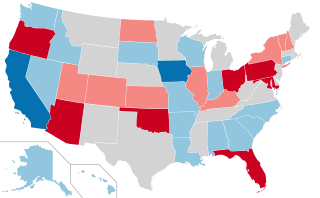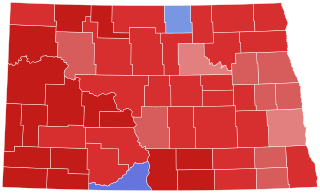
The 1968 United States Senate elections were elections for the United States Senate. Held on November 5, the 34 seats of Class 3 were contested in regular elections. They coincided with the presidential election of the same year. The Republicans picked up five net seats in the Senate. This saw Republicans win a Senate seat in Florida for the first time since Reconstruction.

The 1962 United States Senate elections was an election for the United States Senate. Held on November 6, the 34 seats of Class 3 were contested in regular elections. Special elections were also held to fill vacancies. They occurred in the middle of President John F. Kennedy's term. His Democratic Party made a net gain of four seats from the Republicans, increasing their control of the Senate to 68–32. However, this was reduced to 67–33 between the election and the next Congress, as on November 18, 1962, Democrat Dennis Chávez, who was not up for election that year, died. He was replaced on November 30, 1962, by Republican appointee Edwin L. Mechem. Additionally, Democrat Strom Thurmond became a Republican in 1964, further reducing Democrats to 66–34. This was the first time since 1932 that Democrats gained seats in this class of Senators.

The 1958 United States Senate elections were elections for the United States Senate which occurred in the middle of President Dwight D. Eisenhower's second term. Thirty-two seats of Class 1 were contested in regular elections, the new state of Alaska held its first Senate elections for its Class 2 and 3 seats, and two special elections were held to fill vacancies.

Frank O. Hellstrom was the Democratic contender for Governor of North Dakota in 1912 and 1914 but was defeated by the Republican candidate, L. B. Hanna, both times. He was warden of the North Dakota State Penitentiary at Bismarck, North Dakota.

The 1916 United States Senate election in North Dakota took place on November 7, 1916. Incumbent Senator Porter J. McCumber, a Republican, sought re-election in his first popular election. He won the Republican primary with a plurality and faced former Governor John Burke, the Democratic nominee, and E. R. Fry, the Socialist nominee, in the general election. Though incumbent Democratic President Woodrow Wilson narrowly won the state in the presidential election, McCumber defeated Burke and Fry in a landslide.

The 2020 North Dakota gubernatorial election was held on November 3, 2020, to elect the governor and lieutenant governor of North Dakota, concurrently with other federal and statewide elections, including the U.S. presidential election. Incumbent Republican governor Doug Burgum and lieutenant governor Brent Sanford were both re-elected to a second term.

The 1922 United States Senate election in North Dakota took place on November 7, 1922. Incumbent Republican Senator Porter J. McCumber sought re-election, but was defeated in the Republican primary by Lynn Frazier, the former Governor of North Dakota, who had been recalled in 1921. In the general election, Frazier faced former State Representative James Francis Thaddeus O'Connor, the Democratic nominee. Even as Republicans did poorly nationwide, Frazier narrowly defeated O'Connor to hold the seat.

The 1926 United States Senate election in North Dakota took place on November 2, 1926. Following his re-election in the special election earlier in the year, Senator Gerald Nye ran for re-election to a full term. Despite spurning the Republican Party's endorsement in the special election, Nye ran in the Republican primary in the regular election. On the same day that he defeated former Governor Louis B. Hanna in the special election—in which Hanna had the Republican nomination and Nye ran as the Nonpartisan League candidate—Nye defeated Hanna in the Republican primary for the regular election. Nye once again faced a crowded general election, but emerged victorious in a landslide, winning nearly 70% of the vote while none of his opponents exceeded 15%.

North Dakota held two statewide elections in 2020: a primary election on Tuesday, June 9, and a general election on Tuesday, November 3. In addition, each township elected officers on Tuesday, March 17, and each school district held their elections on a date of their choosing between April 1 and June 30.

The 1936 North Dakota gubernatorial election was held on November 3, 1936. Nonpartisan League nominee William Langer defeated incumbent Republican Walter Welford with 35.80% of the vote.

The 1930 North Dakota gubernatorial election was held on November 4, 1930. Incumbent Republican George F. Shafer defeated Democratic nominee Pierce Blewett with 73.62% of the vote.

The 1924 North Dakota gubernatorial election was held on November 4, 1924.

The 1916 North Dakota gubernatorial election was held on November 7, 1916. Republican nominee Lynn Frazier defeated Democratic nominee D. H. McArthur with 79.24% of the vote.

The 1912 North Dakota gubernatorial election was held on November 5, 1912. Republican nominee L. B. Hanna defeated Democratic nominee Frank O. Hellstrom with 45.45% of the vote.

The 1910 North Dakota gubernatorial election was held on November 8, 1910. Incumbent Democrat John Burke defeated Republican nominee C. A. Johnson with 49.96% of the vote.

Elections were held in Illinois on Tuesday, November 5, 1940.

The 1914 South Dakota gubernatorial election was held on November 3, 1914. Despite a close election in 1912, incumbent Republican governor Frank M. Byrne defeated Democratic nominee James W. McCarter, an Edmunds County Judge, with 50.07% of the vote. Coincidently, Bryne's Democratic opponent in 1912, Edwin S. Johnson, was elected the same year to represent South Dakota in the United States Senate.

The 1916 South Dakota gubernatorial election was held on November 7, 1916. Incumbent Republican Governor Frank M. Byrne declined to seek re-election to a third term. Lieutenant Governor Peter Norbeck won the Republican primary to succeed him, and in the general election faced State Representative Orville V. Rinehart. Norbeck won his first term as Governor in a landslide over Rinehart.

A general election was held in the U.S. state of Wyoming on Tuesday, November 3, 1914. All of the state's executive officers—the Governor, Secretary of State, Auditor, Treasurer, and Superintendent of Public Instruction—were up for election. Governor Joseph M. Carey declined to seek re-election to a second term, and Democratic State Senator John B. Kendrick was elected as his successor. Republicans, however, won all of the other statewide executive offices, including picking up the Superintendent's office.

A general election was held in the U.S. state of Wyoming on Tuesday, November 5, 1918. All of the state's executive officers—the Governor, Secretary of State, Auditor, Treasurer, and Superintendent of Public Instruction—were up for election. Republicans won all statewide offices by wide margins, and with Robert D. Carey's defeat of Frank L. Houx, picked up the governorship following two consecutive losses to Democrats.























